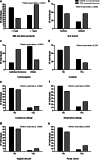Vulvovaginal candidiasis and current perspectives: new risk factors and laboratory diagnosis by using MALDI TOF for identifying species in primary infection and recurrence
- PMID: 33713006
- PMCID: PMC8295079
- DOI: 10.1007/s10096-021-04199-1
Vulvovaginal candidiasis and current perspectives: new risk factors and laboratory diagnosis by using MALDI TOF for identifying species in primary infection and recurrence
Abstract
Vulvovaginal candidiasis (VVC), considered the second cause of genital infection among women, has pathogenic mechanisms still to be elucidated and unknown risk factors. Prevalence studies with laboratory diagnosis (at first diagnosis and recurrence) are uncommon, especially using MALDI TOF, used in this clinical, epidemiological, and laboratory study for evaluating candidiasis, and identifying unknown risk factors. To obtain clinical and epidemiological data, patients were questioned, and there was material collection. Samples collected were identified by using phenotypic and presumptive methods and confirmed by MALDI TOF. This study analyzed 278 patients, divided into symptomatic (n = 173) and asymptomatic (n = 105) groups. Regarding the main candidiasis symptoms (discharge, itching, and burning), only 50.3% of patients described these concomitant symptoms, showing a positive predictive value of 67.8%. Regarding the risk factors investigated, there was a statistical correlation between candidiasis and dairy products, gut transit, contraceptive use, respiratory allergy, and panty liners, describing new risk factors related to intestinal and vaginal dysbiosis. After Candida species analysis and confirmation, the primary prevalence was 80.9% (Candida albicans), 15.2% (non-albicans), 1% (Rhodotorula mucilaginosa), and 1.9% (unidentified species). In recurrence, the prevalence was 66.7% (C. albicans) and 33.3% (non-albicans). The presence of symptoms has low positive predictive value for the diagnosis of candidiasis, even when considering the classic triad of symptoms. Laboratory identification of yeast species is essential for correct treatment, preventing the resistance to antifungals and the high recurrence. In addition, dairy products and bowel habits, both related to intestinal and vaginal dysbiosis, may be associated with VVC.
Keywords: Candida; Candidiasis; Intestinal dysbiosis; Non-albicans; Recurrence; Vaginal dysbiosis; Vaginal vulvovaginitis.
© 2021. The Author(s).
Conflict of interest statement
The authors declare no competing interests.
Figures




Similar articles
-
Prevalence of vulvovaginal candidiasis among pregnant women in the Ho municipality, Ghana: species identification and antifungal susceptibility of Candida isolates.BMC Pregnancy Childbirth. 2020 May 6;20(1):266. doi: 10.1186/s12884-020-02963-3. BMC Pregnancy Childbirth. 2020. PMID: 32375724 Free PMC article.
-
Correlation of Candida species and symptoms among patients with vulvovaginal candidiasis in Maringá, Paraná, Brazil.Rev Iberoam Micol. 2004 Dec;21(4):202-5. Rev Iberoam Micol. 2004. PMID: 15709802
-
Epidemiology and antifungal susceptibility patterns of Candida isolates from Greek women with vulvovaginal candidiasis.Mycoses. 2019 Aug;62(8):692-697. doi: 10.1111/myc.12946. Epub 2019 Jun 12. Mycoses. 2019. PMID: 31132175
-
Candida nivariensis as a New Emergent Agent of Vulvovaginal Candidiasis: Description of Cases and Review of Published Studies.Mycopathologia. 2016 Jun;181(5-6):445-9. doi: 10.1007/s11046-015-9978-y. Epub 2015 Dec 26. Mycopathologia. 2016. PMID: 26708316 Review.
-
Vulvovaginal candidiasis: Epidemiology, microbiology and risk factors.Crit Rev Microbiol. 2016 Nov;42(6):905-27. doi: 10.3109/1040841X.2015.1091805. Epub 2015 Dec 21. Crit Rev Microbiol. 2016. PMID: 26690853 Review.
Cited by
-
Insights and advances in recurrent vulvovaginal candidiasis.PLoS Pathog. 2023 Nov 10;19(11):e1011684. doi: 10.1371/journal.ppat.1011684. eCollection 2023 Nov. PLoS Pathog. 2023. PMID: 37948448 Free PMC article. No abstract available.
-
Reproductive tract microbiome dysbiosis associated with gynecological diseases.Front Cell Infect Microbiol. 2025 Feb 18;15:1519690. doi: 10.3389/fcimb.2025.1519690. eCollection 2025. Front Cell Infect Microbiol. 2025. PMID: 40041148 Free PMC article. Review.
-
Rare Yeasts in Latin America: Uncommon Yet Meaningful.J Fungi (Basel). 2023 Jul 14;9(7):747. doi: 10.3390/jof9070747. J Fungi (Basel). 2023. PMID: 37504735 Free PMC article. Review.
-
Diversity and Antifungal Susceptibilities of Yeasts from Mangroves in Hong Kong, China-A One Health Aspect.J Fungi (Basel). 2024 Oct 20;10(10):728. doi: 10.3390/jof10100728. J Fungi (Basel). 2024. PMID: 39452680 Free PMC article.
-
Microbiological and clinical characteristics of vulvovaginitis in premenarcheal and postmenarcheal girls in a tertiary center in South Korea.Obstet Gynecol Sci. 2025 Mar;68(2):163-173. doi: 10.5468/ogs.24215. Epub 2025 Feb 12. Obstet Gynecol Sci. 2025. PMID: 39938887 Free PMC article.
References
-
- Unemo M, Ballard R, Ison C, Lewis D, Ndowa F (2013) Laboratory diagnosis of sexually transmitted infections, including human immunodeficiency virus.
MeSH terms
LinkOut - more resources
Full Text Sources
Other Literature Sources

